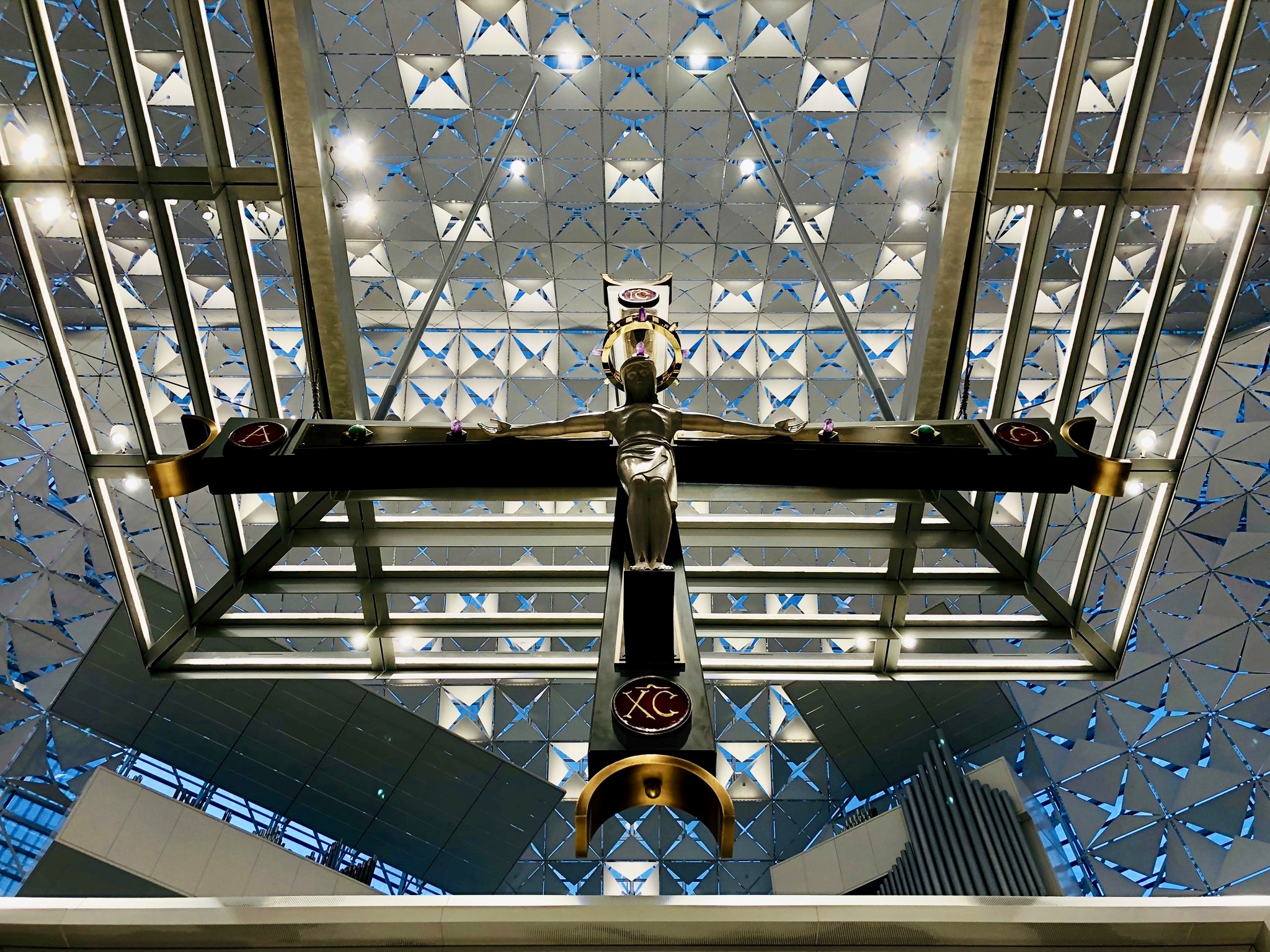On July 17th, the Diocese of Orange solemnly Dedicated its new Christ Cathedral in Garden Grove, California. This was the culmination of a nearly five year, utterly unique project of renovating and repurposing the former Protestant ‘Crystal Cathedral’ to serve as the liturgical Mother Church for the Diocese.
Undoubtedly, such a monumental and challenging project in this day and age, would inevitably prompt reactions from the architectural and liturgical critics that abound. Since its completion, the Diocese and its leadership, have been gratified by the generous and positive responses of those who have had the opportunity of experiencing as well as worshiping within this transformed ‘Catholic’ environment.
The designers, architects and liturgical consultants, however, were not as naive as to think that in this day and age of liturgical tensions fueled by strong ideological feelings and convictions regarding 21st century architecture for worship verses those who are committed to ‘reforming the reform,’ that our project would not prompt vigorous and spirited debate and discussion. We have read with interest these comments and critics who have brought their professional backgrounds as architects, artists and liturgist to bear on their assessments of both the positive as well as perceived negative aspects of this renovation project.
While one would hope that within the household of believers, charity and civility would characterize the vigorous conversations our project has occasioned, sadly, the toxic nature of so much of the polemic these days has witnessed some isolated criticisms that are beyond the pale of civility and have made pointed personal attacks, questioning the orthodoxy of the Bishop as well as all those associated with this renovation project.
Specifically, in this regard, the recent comments on Christ Cathedral by Dr. Peter Kwasniewski, appearing in One Peter 5 (August 21, 2019 - https://onepeterfive.com/dark-symbolism-christ-cathedral/), present such a seriously flawed and personal attack, prompting this response, to assist in setting the record straight. As a frequent contributor to The New Liturgical Movement, a cursory review of Dr. Kwasniewski’s musings and essays, reflect that there is no ambiguity as to where he stands regarding the post-conciliar Church, it’s theology, the reformed liturgy and the contemporary liturgical art that has characterized much of the last and present century. He doesn’t like it! Fair enough. As is often said, ‘the Church is a big tent!’ In the world of sacred art, one could be enamored by the striking beauty of Chartres Cathedral and less attracted aesthetically by the Chagall Chapel of Saint-Paul de Vence. Personal taste and sensibility understandably vary.
It is one thing, however, to voice one’s own artistic preferences – likes and dislikes, verses, arrogantly raising them to be the final arbiter of what is or what is not beautiful, worthy, fitting and congruent for the Glory of God in sacred worship. Sadly, the author has crossed that line.
However, I take great objection and umbrage at the central accusation that he has made regarding the entire Christ Cathedral project, as evidenced in the following statements:
What is clear is that a choice was made to avoid normative Christian symbolism and to make use of signs associated with other religious traditions — elements that narrate a tale as shocking and scandalous as any report covering the abuse crisis.
But even if a cloaked message were not the objective of the artwork, the entire edifice remains a scandal, if for no other reason than the low quality of the work commissioned, the ugly manner in which holy persons are depicted, and the near comical awkwardness with which the mysteries of the Catholic Faith are proposed. It places a modernist caricature of the Faith before the eyes of those unfortunate enough to enter within it.
The author would have the reader believe that there was a sinister cabal at work among the Bishop, architects and liturgical consultants, to purposely deconstruct the true essence of the Catholic liturgical tradition in shaping this neo architectural whore of Babylon as part of a modernist plot to subvert orthodoxy!
The author’s overactive imagination, fueled by perhaps one too many bad Dan Brown novels, is truly an embarrassment to anyone who purports to be a serious and conscientious student of the Church’s rich liturgical, artistic and architectural patrimony.
As a member of the liturgical team charged with working with the architects and designers for the renovation project since its inception, permit me to put the record straight, if there be a scintilla of ambiguity or doubt: “No, Dr. Kwasniewski, the careful planning, design and execution for the repurposing of the former “Crystal Cathedral” into Christ Cathedral, had no ulterior motive other than to reflect not only the liturgical norms and directives for the shaping of a Cathedral Church in this post-conciliar period, but also, to draw upon the artistic genius of the artists of this age to capture visually something of the ineffable beauty and mystery of the Holy Ones whose lives have been transformed by the Mystery of Christ. There is no ‘counter-catechism’ here, but rather a ‘house for all God’s holy Church,’ drawing God’s people ever more deeply into the Eucharistic mystery that continues to shape our identity as a people of faith down through the ages. Perhaps the simple fact that our new Cathedral now draws some 14,000 to 15,000 faithful a week for weekend worship is a testimony to its power to inspire and edify by its beauty.
The Rev. Dr. Robert Schuller to whom the Diocese of Orange is indebted for providentially bringing to full circle his campus as now the seat of our local Church, was a member of the Reformed Church. One of their esteemed theologians of the 20th century, Reinhold Niebuhr, once said that, “Frantic orthodoxy is never rooted in faith but in doubt. It is when we are not sure that we are doubly sure.” Perhaps, Dr. Kwasniewski could pause a bit from hurling anathemas in the name of orthodoxy and rediscover the virtue of Christian humility.
